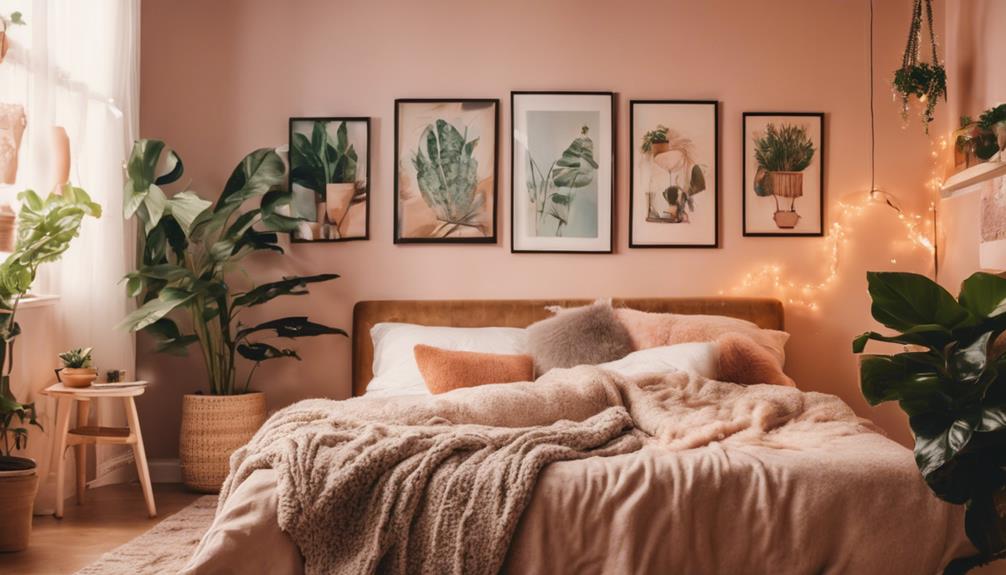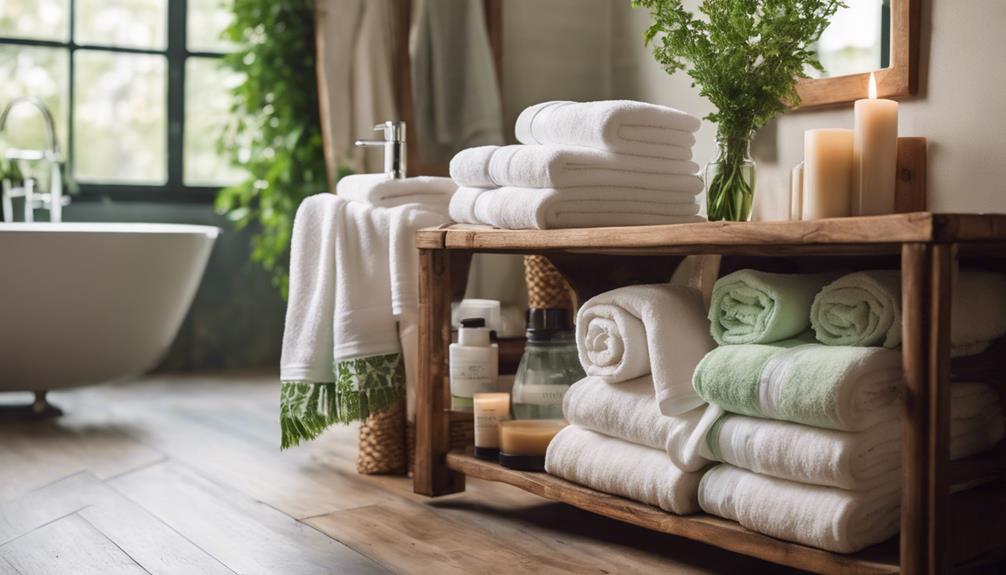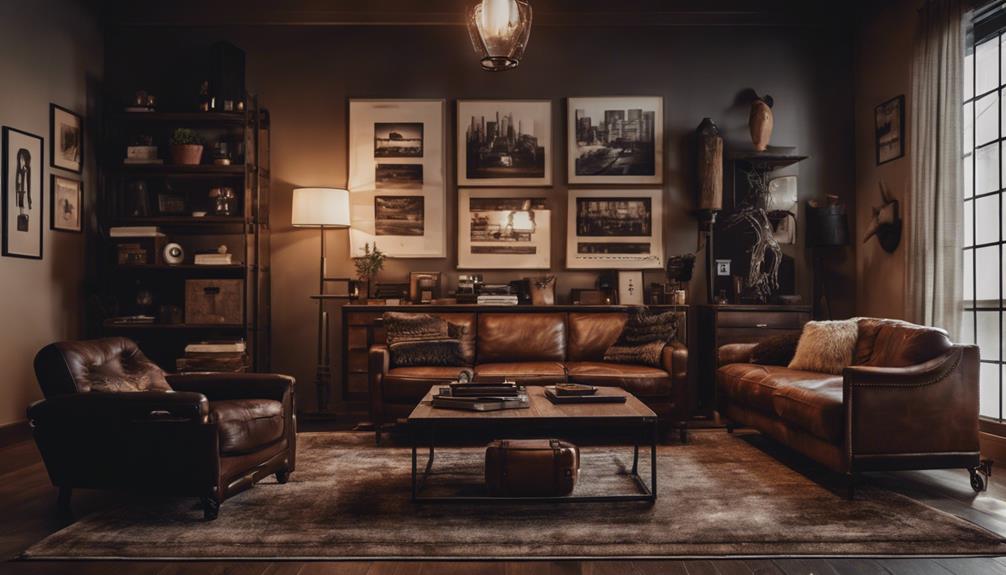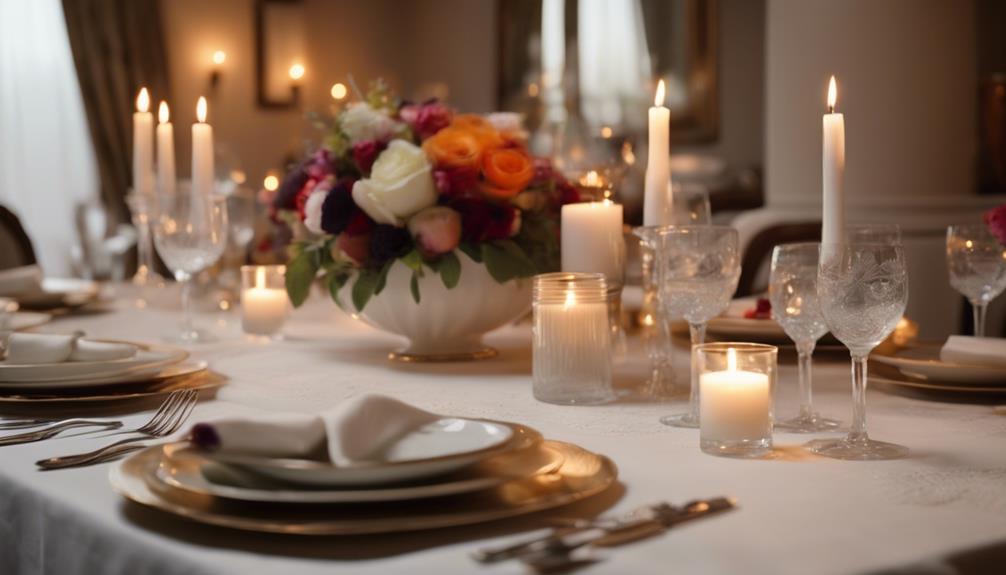You can easily transform your space with aesthetic room decor that wows everyone. Start by choosing a cohesive color palette that combines lighter tones with bold accents to create depth. Incorporate textured fabrics like velvet and linen for warmth, and mix materials such as wood and stone to enhance your ambiance. Opt for striking light fixtures like pendant lamps to set the mood. Don't forget decorative elements like botanical wall art and unique planters to bring life into your room. With these ideas, you'll create a stylish oasis that reflects your personality and impresses your guests. Explore more insights to elevate your decor!
Key Elements
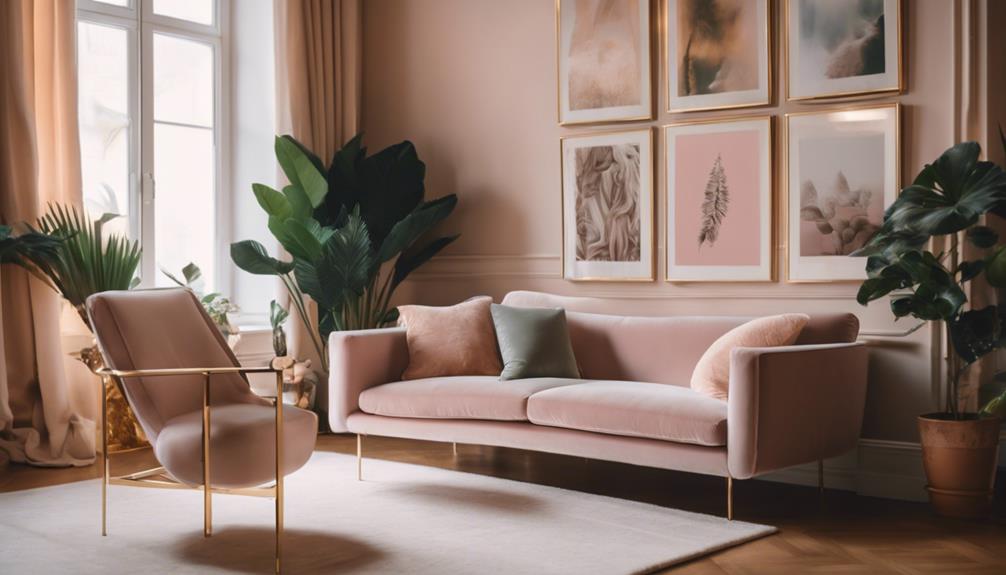
When creating your aesthetic room decor, the color scheme is essential in setting the overall mood.
Choosing the right materials and textures can add depth and warmth, making the space feel inviting.
Let's explore how these key elements work together to elevate your room's style.
Color Scheme
A cohesive color palette unifies your room decor, typically featuring one foundation color paired with complementary accent shades to enhance the overall ambiance. Start by selecting a foundation color that resonates with you and sets the tone for your room aesthetic. Lighter tones can brighten spaces with limited natural light, while bold accents can energize your environment when used thoughtfully.
Before committing to a full room application, test paint colors in small areas. This helps you see how they interact with both lighting and existing decor. Incorporating trending colors, like earthy tones or pastels, can add a modern touch and keep your space feeling fresh and inviting.
Don't forget the power of textures and patterns within your chosen color scheme. Mixing these elements can create depth and visual interest, elevating your room's overall aesthetic appeal. Remember, a well-thought-out color palette not only ties your decor together but also reflects your personality.
Materials
Choosing the right materials can dramatically elevate your room's aesthetic, making it feel both inviting and stylish.
Start with wall decor; opt for art prints that resonate with your theme. Larger prints work wonders in spacious areas, while smaller pieces can create a gallery effect.
Incorporate textured fabrics like velvet and linen for your cushions and throws to add depth and warmth, ensuring your space feels cozy.
Don't forget about mirrors! They not only bring elegance but also reflect natural light, creating an illusion of a larger room.
For a touch of nature, introduce materials like wood and stone, which contribute to an organic feel. Adding low-maintenance indoor plants can purify the air and provide visual interest.
Plus, statement furniture pieces are essential. Look for bold colors or unique designs that define your style and offer functional storage solutions.
Finally, consider seasonal decor changes. Swapping out cushions and throws can refresh your room's look, allowing you to incorporate trending colors and motifs.
Textures
Textures enrich your room's ambiance, inviting tactile exploration and visual interest that can transform any space. When you mix materials like velvet, linen, and cotton, you create a rich and inviting atmosphere that enhances your room design. Layering different fabrics, such as throws and pillows, not only adds warmth but also introduces varied tactile experiences, elevating the overall decor.
Rugs play a significant role in adding texture, with natural fiber options providing a soft underfoot feel while defining different areas within your space. They can pull a room together, bringing comfort and style simultaneously. Additionally, incorporating textured wall treatments like faux brick or 3D wall panels adds character, turning flat surfaces into dynamic focal points.
Don't forget the power of mixing smooth and rough textures. Combining sleek decor items with rustic elements can create a balanced and engaging aesthetic that captures attention. By thoughtfully integrating textures into your room design, you enhance both visual depth and comfort, ensuring your space feels inviting and stylish.
Essential Fixtures and Furniture
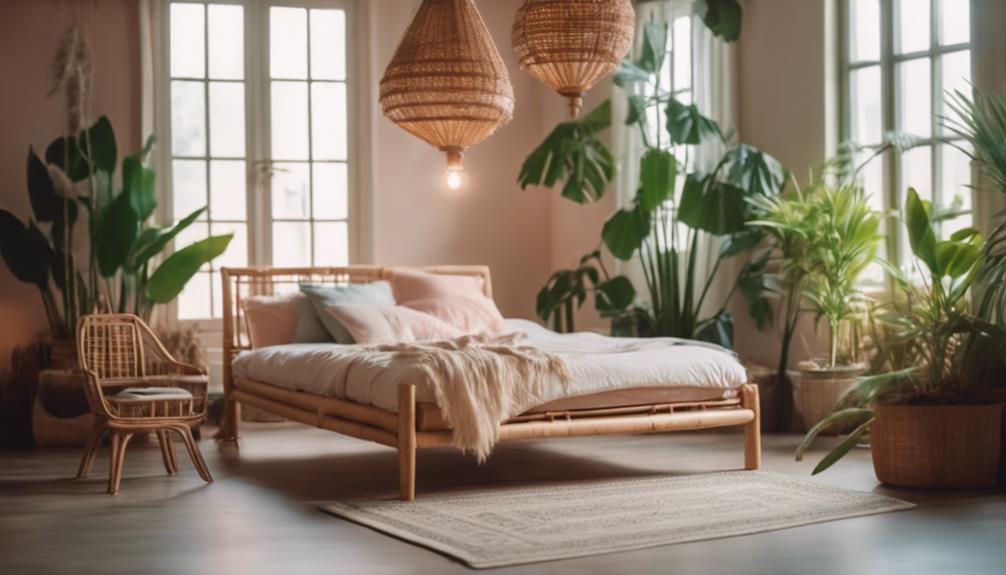
When it comes to essential fixtures and furniture, you'll want to focus on pieces that blend style and functionality.
A vintage wooden side table can add character, while a sleek glass coffee table brings a modern touch to your space.
Don't forget about a hanging pendant light fixture to create ambiance and elevate the overall design of the room.
Vintage Wooden Side Table
A vintage wooden side table brings a unique charm and warmth to your space, showcasing intricate craftsmanship and the rich history of its materials. When you incorporate a vintage wooden side table into your decor, you immediately add personality to the room. These tables often feature stunning grain patterns and durable hardwoods like oak, walnut, or mahogany, ensuring they stand the test of time.
Versatile by design, vintage side tables can function as nightstands, accent tables, or display surfaces for your favorite decorative items, such as lamps or plants. Many of these tables come with functional features like drawers or shelves, providing you with practical storage solutions while enhancing the aesthetic appeal of your space.
Sourcing your vintage wooden side table from flea markets, antique shops, or online marketplaces not only allows you to find unique pieces but also promotes sustainability by reusing quality materials. By choosing a vintage wooden side table, you can create a warm, inviting atmosphere that reflects your personal style and transforms your space into a stunning showcase of character and history.
Hanging Pendant Light Fixture
Hanging pendant light fixtures not only illuminate your space but also serve as striking focal points that elevate your room's overall aesthetic. These pieces of statement lighting come in various designs, materials, and colors, allowing you to find the perfect match for your decor style—be it industrial, bohemian, or something entirely unique.
You can hang these fixtures individually for a minimalist effect or cluster them together to create a fascinating lighting arrangement that adds depth and interest to your space. Many pendant lights feature adjustable heights, giving you the flexibility to customize your lighting based on your ceiling height and personal preferences. This adaptability guarantees that your room feels cozy and inviting while providing ideal illumination.
If you're looking for a sustainable lighting solution, consider the energy-efficient LED options available. Not only do they reduce energy consumption, but they also help lower your costs, making them a smart choice for the eco-conscious decorator.
Sleek Glass Coffee Table
Elevating your living space, a sleek glass coffee table not only enhances the room's aesthetic but also creates an illusion of openness, making it perfect for smaller areas. By reflecting light, this stylish piece can visually enlarge your space, allowing you to maximize every inch of your home. Its minimalist design complements various decor styles, from modern to mid-century, ensuring it fits seamlessly into your existing theme.
When you choose a glass coffee table, you're also opting for functionality. Many designs come with integrated storage or unique bases, adding practicality without sacrificing style. Plus, maintaining your table is a breeze; a simple glass cleaner is all you need to keep its surface sparkling and free from smudges.
Another significant advantage of glass coffee tables is their versatility. The transparency of the material allows them to blend effortlessly with other furniture, creating a cohesive decor theme.
Lighting Ideas
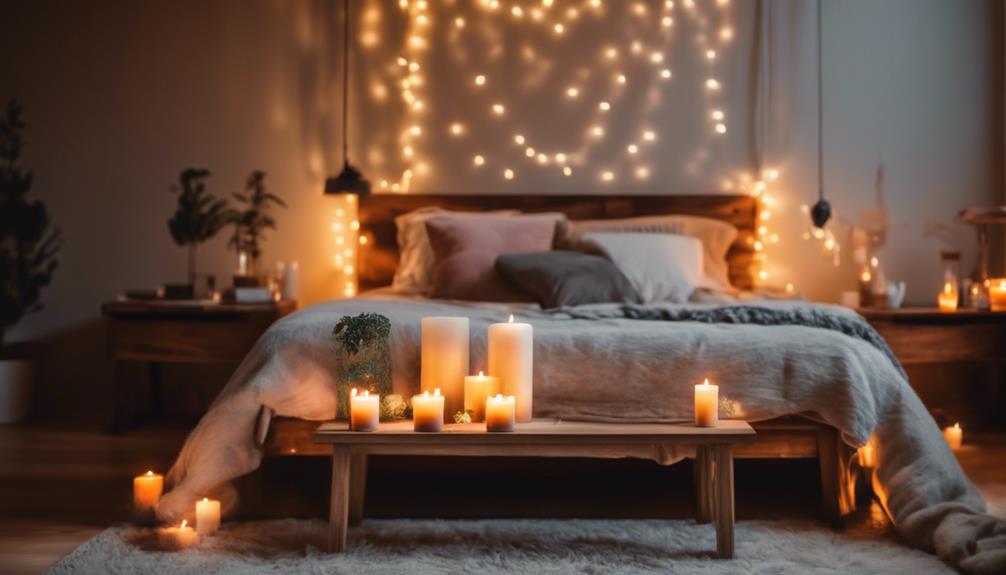
When it comes to lighting, choosing the right fixtures can transform your space considerably.
Think about incorporating chic pendant light clusters or soft ambient floor lamps to create a warm atmosphere.
You might also consider a vintage Edison bulb chandelier or artistic LED strip lighting for that extra flair and personality.
Chic Pendant Light Cluster
A chic pendant light cluster transforms your space by adding depth and character through a harmonious arrangement of lights at varying heights. This layered lighting effect creates visual interest and enhances the overall ambiance of your room style. By choosing pendant lights in complementary colors and designs, you can unify your decor while expressing your personal taste.
These versatile lighting options typically range from $30 to $200, accommodating various budgets. Opting for dimmable pendant lights allows you to adjust brightness levels, setting a cozy atmosphere perfect for dining areas or reading nooks. When installing your chic pendant light cluster, aim for a height that complements your room's proportions—generally hanging them 30 to 36 inches above dining tables or counters guarantees effective illumination.
As you plan your lighting, consider how the cluster interacts with other elements in the room. A well-designed pendant light arrangement not only illuminates but also serves as a stunning focal point, enhancing your overall decor. With the right choices, your chic pendant light cluster will wow everyone who enters your space!
Soft Ambient Floor Lamps
Soft ambient floor lamps create a warm and inviting atmosphere, perfect for unwinding after a long day. They provide gentle, diffused lighting that enhances relaxation and comfort in your space. With many options available, you can find lamps with adjustable brightness or color temperature settings, allowing you to customize the light to match your mood or activity.
By incorporating unique designs, like arc or tripod styles, you can add a touch of elegance to your decor. These stylish pieces serve as functional lighting while also acting as statement elements that elevate your room's aesthetic. Placing soft ambient floor lamps in corners or beside seating areas not only improves the spatial layout but also adds depth and dimension to your design.
Moreover, choosing energy-efficient LED bulbs for your lamps promotes sustainability and helps reduce electricity costs. With their long lifespan, these bulbs guarantee that you can enjoy the beauty and functionality of your soft ambient floor lamps for years to come.
Vintage Edison Bulb Chandelier
The Vintage Edison Bulb Chandelier combines nostalgic charm with modern elegance, instantly transforming your space into a cozy haven.
Featuring exposed filament bulbs, this chandelier casts a warm, inviting glow that creates a comforting atmosphere in any room. Whether you hang it in your dining area, living room, or entryway, it serves as a striking focal point that draws attention and enhances your decor.
Crafted from materials like wrought iron or antique brass, the vintage Edison bulb chandelier adds a touch of rustic charm that complements various design aesthetics, from industrial to farmhouse. Plus, many models come with adjustable heights, making them versatile for spaces with high ceilings or more intimate settings.
When you opt for energy-efficient LED Edison bulbs, you'll not only enjoy a beautiful lighting feature but also save on energy costs. These bulbs can last up to 25,000 hours, considerably reducing your energy consumption compared to traditional incandescent options.
With so many styles available, the vintage Edison bulb chandelier can elevate your room's ambiance while marrying function and beauty effortlessly.
Artistic LED Strip Lighting
Artistic LED strip lighting allows you to effortlessly customize your space with vibrant colors and enchanting effects, transforming any room into a dynamic environment. With millions of color options and programmable effects, you can easily add color that matches your mood or occasion. Whether you want a soft glow for a cozy evening or a lively display for a party, these LED strips have you covered.
One of the best features of LED strip lights is their energy efficiency. They consume considerably less power than traditional lighting and can last up to 50,000 hours, saving you both energy and money. Plus, many come with remote control or smart home integration, so you can adjust brightness and colors from anywhere in the room.
Their flexible design allows you to install them in various locations like under shelves or along ceilings, enhancing architectural features and adding depth. If you're feeling adventurous, try the music synchronization option to create dynamic light shows that react to sound, making any gathering unforgettable.
Embrace the versatility of artistic LED strip lighting and watch your space come alive!
Decorative Elements
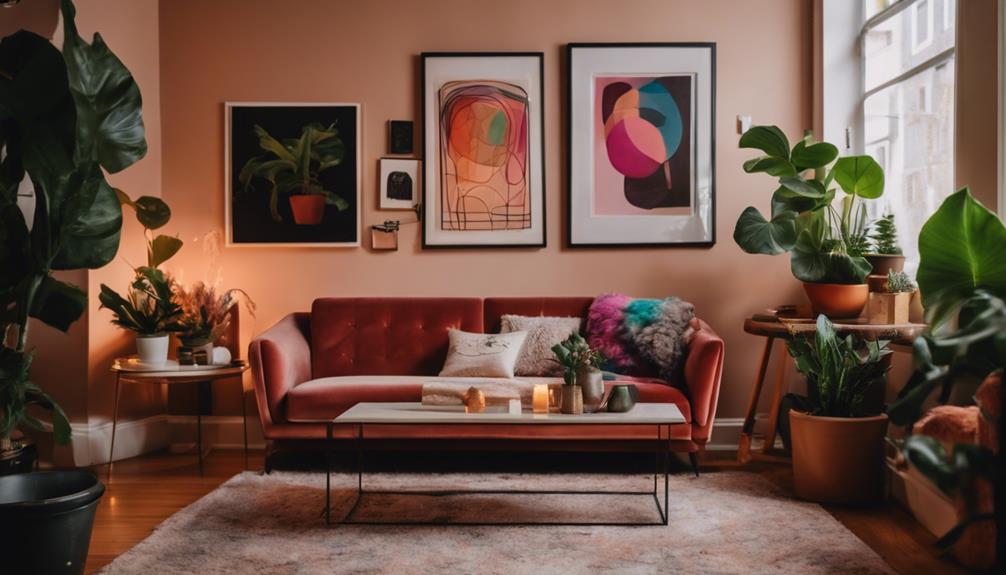
You can transform your space with decorative elements like framed botanical wall art, ceramic geometric planters, and textured woven wall hangings.
These details not only enhance visual appeal but also infuse your personality into the room.
Let's explore how each of these features can elevate your aesthetic decor.
Framed Botanical Wall Art
Framed botanical wall art brings a revitalizing touch of nature indoors, instantly enhancing your room's aesthetic. This type of artwork adds a calming and organic feel, creating an inviting atmosphere for you and your guests. With styles ranging from vintage illustrations to abstract designs and vibrant color palettes, you can easily find pieces that match your unique decor theme.
Incorporating framed botanical art doesn't just beautify your space; it can also promote well-being. Nature-inspired decor has been shown to reduce stress and improve mood, making it a smart addition to any room.
To create a stunning gallery wall, mix different frame styles and sizes. This approach adds visual interest and serves as an engaging focal point.
When selecting botanical prints, consider how they align with your room's color palette. Choosing pieces that complement your existing decor will unify the space, resulting in a cohesive and sophisticated look.
Ceramic Geometric Planter
Building on the natural appeal of framed botanical wall art, a Ceramic Geometric Planter adds a contemporary touch that enhances any room's decor. With its modern design characterized by clean lines and sharp angles, this planter acts as a stylish focal point. Available in various sizes and colors, you can easily integrate the Ceramic Geometric Planter into your aesthetic room decor, whether you lean toward minimalistic or bohemian themes.
Made from high-quality ceramic, these planters offer durability, making them suitable for both indoor and outdoor use. They not only elevate your decor but also support the longevity of your plants. The unique geometric shapes create visual interest and allow for exciting arrangements when combined with other planters or decorative elements.
Moreover, incorporating a Ceramic Geometric Planter helps improve air quality while bringing a touch of nature indoors. This contributes to a calming and inviting atmosphere, making your space feel more vibrant and alive. So, if you want to transform your room with style that will wow everyone, consider adding these chic planters to your decor.
Textured Woven Wall Hanging
How can a textured woven wall hanging transform your space by adding depth and warmth to your decor? These stylish pieces serve as more than just art; they're essential decorative elements that enhance the overall ambiance of any room.
Crafted from materials like cotton, wool, and jute, textured wall hangings come in various styles, allowing you to find the perfect fit for your aesthetic. By hanging a woven wall piece at eye level, you create a striking focal point that draws attention and sparks conversation.
Besides their visual appeal, these textured wall hangings also act as sound absorbers, helping to reduce echoes in larger spaces. This dual functionality not only elevates your decor but also improves your room's acoustics.
Available in an array of sizes and patterns, you can seamlessly integrate a textured woven wall hanging into your existing color palette or decor theme. Whether you prefer bold statements or subtle accents, these pieces are sure to wow your guests while adding that essential touch of warmth and depth to your space.
Transform your room today by incorporating a stunning woven wall hanging!
Flooring

When it comes to flooring, your choice can set the tone for the entire room.
You might consider reclaimed hardwood for rustic charm, polished concrete for a sleek modern vibe, or luxury vinyl plank for its durability and versatility.
Each option brings its own unique aesthetic, allowing you to express your personal style.
Reclaimed Hardwood for Rustic Charm
Reclaimed hardwood flooring adds a unique touch of rustic charm to your space, showcasing the beauty of salvaged wood with its distinct knots and color variations. Each plank tells a story, bringing history and character that new materials simply can't match. This aesthetic choice not only enhances your decor but also promotes sustainability by reducing waste and deforestation.
You'll find that reclaimed hardwood is often more durable than its new counterparts. Having gone through natural aging, it's less prone to warping and splitting, making it a smart investment for your home. Plus, its unique textures and tones can create a warm, inviting atmosphere that impresses guests and makes you feel at ease.
Another significant benefit is the improvement in indoor air quality. By choosing reclaimed wood, you're opting for a healthier living environment, as it reduces the need for synthetic materials that can emit harmful chemicals.
Polished Concrete for Modern Appeal
Polished concrete flooring offers a sleek and modern appeal that enhances any space while providing unmatched durability and low maintenance. This flooring option is perfect for high-traffic areas due to its resistance to stains, moisture, and wear. With its reflective surface, polished concrete can make your room look brighter and more open, maximizing the natural light that flows in.
You'll love the versatility of polished concrete, as it's available in various finishes and colors. This means you can customize it to match your unique design style, whether you prefer an industrial vibe or a contemporary aesthetic. The process of polishing involves grinding the surface with diamond pads, allowing you to select the desired level of shine and smoothness that fits your vision.
Additionally, polished concrete is an environmentally-friendly choice. By utilizing existing concrete slabs, it reduces the need for additional materials, aligning with sustainable building practices.
If you want to transform your space with a flooring option that combines beauty, durability, and style, polished concrete is definitely worth considering! It'll not only elevate your decor but also provide long-lasting functionality.
Luxury Vinyl Plank for Durability
If you're looking for a flooring option that combines stunning aesthetics with exceptional durability, luxury vinyl plank (LVP) is an excellent choice. LVP is specifically designed to withstand the rigors of daily life, making it perfect for high-traffic areas in your home or commercial space. Its resistance to scratches, stains, and wear guarantees that your floors maintain their beauty over time.
Beyond its durability, LVP mimics the look of natural wood or stone, providing a stylish finish without the upkeep associated with traditional materials. You can confidently install it in moisture-prone areas like bathrooms and kitchens, thanks to its waterproof construction, which also minimizes the risk of mold and mildew.
Installation is a breeze, featuring user-friendly click-lock systems that allow you to transform your space quickly and efficiently, often without professional help. With a wide variety of colors, textures, and styles available, luxury vinyl plank enables you to create the aesthetic you desire while enjoying a robust flooring solution that stands the test of time.
Embrace the blend of beauty and durability with LVP for an impressive and lasting impact in your home.
Conclusion
Transforming your space with aesthetic room decor is all about blending style and personal touch.
By incorporating key elements like essential fixtures, thoughtful lighting, and unique decorative pieces, you can create an environment that reflects your personality and impresses everyone.
Don't forget the flooring—it's the foundation of your room's vibe.
Embrace creativity, experiment with different styles, and watch as your space evolves into a stunning sanctuary that feels uniquely yours!
